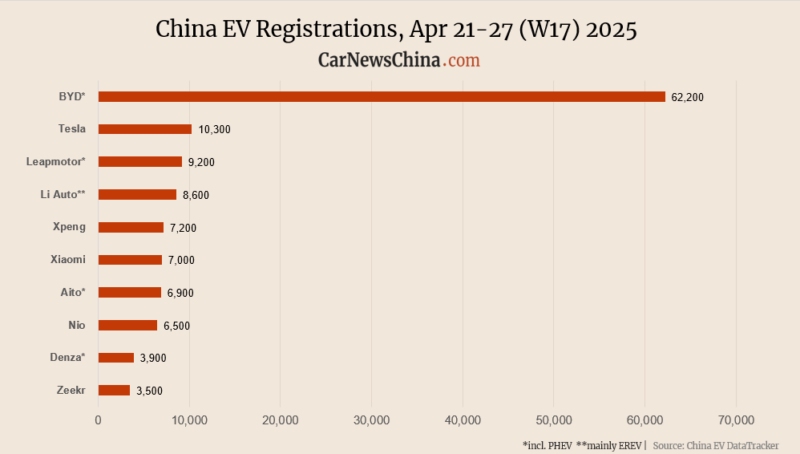In the fourth week of April, the China EV market was mainly up, with several exceptions. Nio was up 20%, Tesla was up 52%, and BYD was up 11%, while Xiaomi was 3% down compared with the week before.
The weekly sales were published by Li Auto. However, Li Auto ceased publishing them in March after the China Association of Automobile Manufacturers (CAAM) “recommended” that Li Auto, the media and any third parties end it. CAAM says weekly data “undermines the industry order” and “fuels vicious competition.” Since then, Li Auto has published only its own EV registration.
The weekly data are used by consultants, analysts, or investors to see the sales trend and forecast monthly deliveries. They show how many cars were registered for road traffic, which can be later compared with automakers’ self-reported monthly sales, which, unlike registrations, include cars for showrooms, test cars, and other uses.
China-controlled media have followed CAAM’s recommendation to stop publishing weekly figures. CarNewsChina continues to publish weekly insurance registrations, based on China EV DataTracker data.
The numbers are rounded and present new energy vehicle (NEV) sales, the Chinese term for BEVs, PHEVs, and EREVs (range extenders). To be completely precise, it also includes hydrogen vehicles (FCEVs), but their sales are almost non-existent in China.
Week 17 of 2025 (W17) was between April 21 and 27.
BYD led the week of April 21–27 with 62,200 registrations, a 10.5% increase over the previous week’s 56,300. In the first four weeks of April (April 1–27), BYD registered 217,000 vehicles in China.
BYD’s Denza reported 3,900 registrations, an 18.2% gain from 3,300 a week earlier. In the first four weeks of April, Denza registered 12,800 vehicles in China.
Fang Cheng Bao registered 3,300 units, 65% up from 2,000 units the week before.
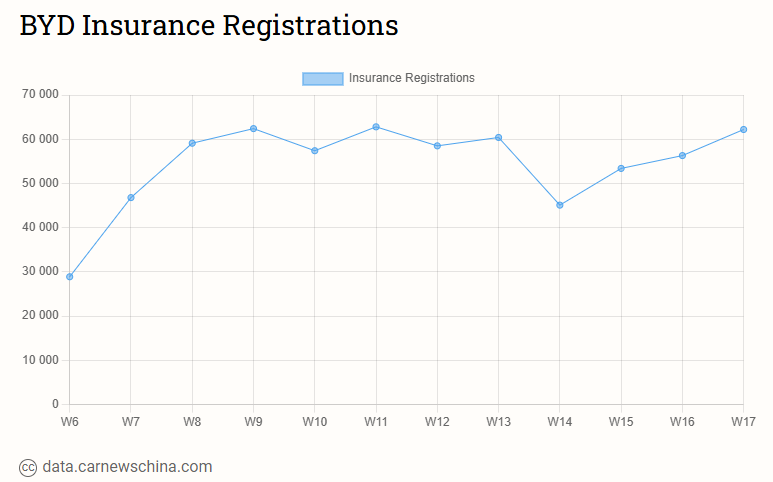
Tesla recorded 10,300 registrations, rising 51.5% from 6,800 the week before. In the first four weeks of April, Tesla registered 26,100 vehicles in China.
Tesla China sold 78,828 vehicles in March, including domestic sales and overseas shipments from Giga Shanghai. This is 11.5% down from 89,064 units last year and up 156.9% from 30,688 units in February.
Model sales breakdown:
- Model Y: 7,100
- Model 3: 3,200
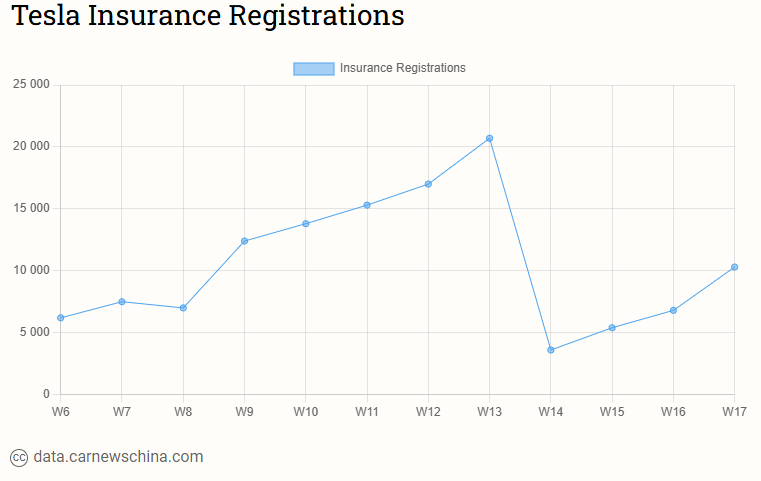
Stellantis-backed Leapmotor posted 9,200 registrations, a 7.0% increase from the previous week’s 8,600. In the first four weeks of April, Leapmotor registered 29,600 vehicles in China.
For Leapmotor, this is a record-breaking week in 2025, also it outsold all Li Auto and all other Chinese EV startups.
Li Auto saw 8,600 registrations, down 2.3% from 8,800 a week earlier. In the first four weeks of April, Li Auto registered 30,800 vehicles in China.
Li Auto sells mainly EREV SUVs. Last year, it launched its first all-electric car, Li Mega. However, the sales were disastrous for the coffin-like vehicle. In response, Li Auto delayed the launch of another all-electric model to Q2 2025 – it will be an all-electric SUV, Li Auto i8, which was already teased in spy shots.
Li Auto reportedly aims to sell 700,000 cars in 2025. In 2024, the company sold 500,508 vehicles.
Volkswagen-backed Xpeng achieved 7,200 registrations, a 9.1% rise from 6,600 in the prior week. In the first four weeks of April, Xpeng registered 28,000 vehicles in China.
Xpeng’s monthly delivery volume has exceeded 30,000 vehicles for the fifth consecutive month as the company announced 33,205 delivered units in March. The Mona M03 entry-level sedan has powered its deliveries, contributing about half of the sales in the last three months. Mona M03 recently reached 100,000 produced units, 216 days after the launch.
Xiaomi had 7,000 registrations, slipping 2.8% from 7,200 the week before. In the first four weeks of April, Xiaomi registered 25,600 vehicles in China.
Last month, Beijing-based smartphone giant raised its 2025 delivery target by 50,000 units to 350,000 vehicles.
In 2024, the company delivered 135,000 vehicles.
Model breakdown:
- Xpeng Mona M03: 2,500
- Xpeng G6: 1,700
- Xpeng P7+: 1,600
- Xpeng G9: 860
- P5 + P7: 100
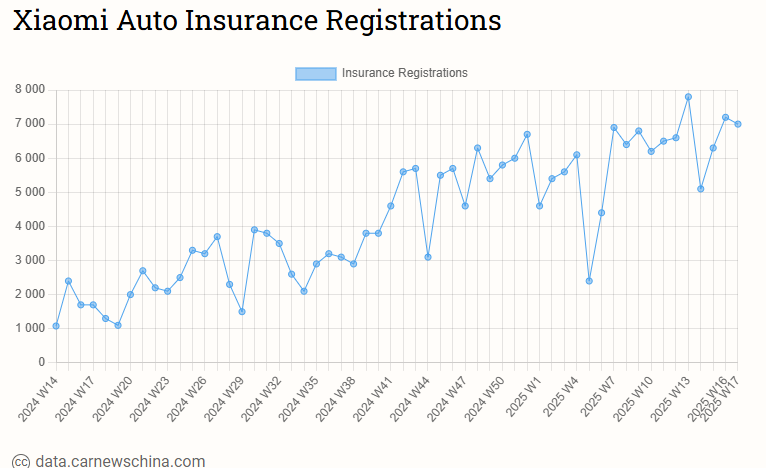
Aito reached 6,900 registrations, up 56.8% from 4,400 the previous week. In the first four weeks of April, Aito registered 19,300 vehicles in China.
Nio recorded 6,500 registrations, marking a 20.4% increase over 5,400 the week prior. In the first four weeks of April, Nio registered 17,200 vehicles in China.
For Nio, it marks a third consecutive week of growth and the third-best week in its history. It only sold more cars in weeks 22 and 26 of 2024, when it sold 6,700 and 6,800 units, respectively.
The increase in registrations was caused by the stimulus introduced in early April. Nio ramped up incentives to boost sales and clear inventory ahead of the launch of facelifted models. New Nio buyers can get 5 years of free battery swap, with a cap of 240.
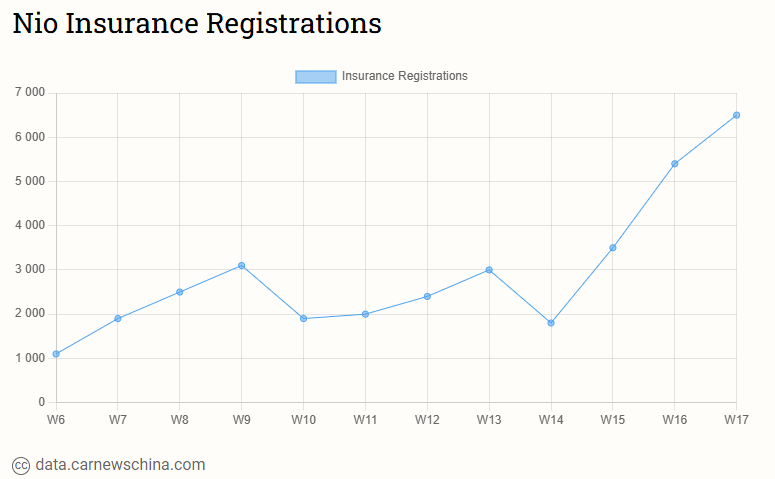
Nio’s Onvo recorded 1,500 registrations, up 93.5% from 775 the previous week. In the first four weeks of April, Onvo registered 3,705 vehicles in China.
Onvo sells a single model, an L60 SUV, launched in September 2024 to compete with the Tesla Model Y. Its initial monthly sales target was to reach 10,000 units in December and 20,000 in March.
The December target was achieved with little help from selling cars to its own employees. However, the March target of 20,000 units was strongly missed; the brand delivered only 4,820 vehicles. As a result, Onvo CEO Alan Ai resigned and was replaced by Shen Fei, head of Nio Power.
Onvo will soon launch its second car, the massive SUV L90, which had its public debut last week at the Shanghai Auto Show, revealing a massive frunk. It will compete with Li Auto L9 and Aito M9 and most likely cannibalise sales of Nio’s first mass-produced EV, the ES8.
Nio Group’s sales target is about 440,000 vehicles in 2025 of which Onvo should contribute half. Last year, the company delivered 220,000 vehicles.
Nio’s third brand launched its first EV, Firefly, on April 19. Yes, the brand’s name is Firefly, and the name of the EV is also Firefly. The small electric hatchback starts at 125,800 yuan (16,770 USD) with a battery.
Firefly supports battery swap. However, it can’t swap batteries currently as there are no compatible swap stations. The container swap stations dedicated to Firefly were scrapped, and the fifth-generation swap station, which should support the Nio brand, Onvo, and Firefly, will launch next year with limited availability.
Firefly will launch between June and August in Europe.
Together, Nio Group registered 8,000 vehicles, up 29% from 6,200 vehicles the week before.
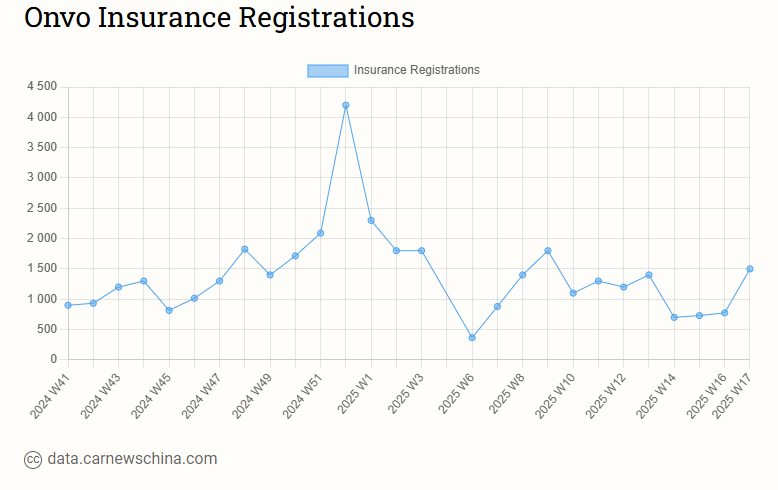
Geely’s Zeekr posted 3,500 registrations, up 29.6% from 2,700 the previous week. In the first four weeks of April, Zeekr registered 11,200 vehicles in China.
Avatr saw 2,200 registrations, a 57.1% jump from 1,400 the prior week. In the first four weeks of April, Avatr registered 6,400 vehicles in China.
Follow us for ev updates



